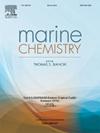乌拉巴湾-哥伦比亚加勒比海地区的沉积和金属积聚:150年的自然过程和人类影响记录
IF 2.5
3区 地球科学
Q2 CHEMISTRY, MULTIDISCIPLINARY
引用次数: 0
摘要
自然和人为因素控制着河口泥沙堆积速率和金属沉积。本研究分析了过去150年来乌拉巴湾(哥伦比亚加勒比海南部)沉积速率和金属积累的变化。采用基于210Pb同位素的恒通量(CF)模型确定了C1、C2和C3 3个岩心的沉积速率,平均沉积速率分别为0.14 cm/y、0.22 cm/y和0.10 cm/y。主要金属(Al、Fe、Ca、Mn)和次要金属(Zn、Cr、Cu、Ni)的时间分布揭示了主要支流口迁移、土地集约利用变化和极端气候事件等重要历史事件。与前人研究结果一致,考虑全球地壳参考值,利用富集因子、人为因子和地成藏指数3个地球化学指标,发现该区存在中度污染和金属富集。然而,当考虑到在底部岩心沉积物(2583 y BP)中测定的当地背景金属浓度时,缺乏或最小的污染是明显的。因此,本研究证明了利用当地背景来确定地表沉积物和岩心中金属污染的相关性。尽管海湾有大量的淡水输入和沉积物供应,以及人为活动,但由于盐楔侵入的存在,与全球其他海洋环境相比,沉积速率和金属积累较低。盐楔产生了密度差,导致沉积物中的粘土部分以及相关污染物在较长时间内悬浮。结果,沉积受到阻碍,这些物质被运出海湾。因此,细粉砂和中粉砂在河口沉积和金属堆积动力学中占主导地位。本文章由计算机程序翻译,如有差异,请以英文原文为准。
Sedimentation and metal accumulation in the Gulf of Urabá – Colombian Caribbean: A 150-year record of natural processes and human impacts
Natural and human factors control the sediment accumulation rates and metal deposition in estuaries. This study analyzes the changes in sedimentation rates and metal accumulation in the Gulf of Urabá (southern Colombian Caribbean) over the last 150 years. The sedimentation rates of three cores (C1, C2, and C3) were determined using the constant flux (CF) model based on the 210Pb isotope, averaging 0.14 cm/y, 0.22 cm/y and 0.10 cm/y, respectively. The temporal distribution of both major (Al, Fe, Ca, Mn) and minor (Zn, Cr, Cu, Ni) metals revealed important historical events, including the relocation of the main tributary mouth, intensive land use changes, and extreme climatic events. In agreement with previous studies in the area, moderate contamination and metal enrichment were found based on three geochemical indices (enrichment factor, anthropogenic factor and geo-accumulation index) considering global crust reference values. However, a lack of or minimal pollution was evident when considering the local background metal concentrations, which were determined in the bottom core sediments (2583 y BP). Therefore, this study evidences the relevance of using local background to determine metal pollution in surface sediments and cores. Despite high freshwater inputs and sediment supply, as well as anthropogenic activities in the gulf, sedimentation rates and metal accumulation are low compared to other marine environments worldwide, due to the presence of a salt wedge intrusion. The salt wedge creates a density difference, causing the clay fraction of the sediments, along with associated pollutants, to remain suspended for extended periods. As a result, sedimentation is hindered, and these materials are transported out of the gulf. Consequently, fine and medium silt dominate sedimentation and metal accumulation dynamics in the estuary.
求助全文
通过发布文献求助,成功后即可免费获取论文全文。
去求助
来源期刊

Marine Chemistry
化学-海洋学
CiteScore
6.00
自引率
3.30%
发文量
70
审稿时长
4.5 months
期刊介绍:
Marine Chemistry is an international medium for the publication of original studies and occasional reviews in the field of chemistry in the marine environment, with emphasis on the dynamic approach. The journal endeavours to cover all aspects, from chemical processes to theoretical and experimental work, and, by providing a central channel of communication, to speed the flow of information in this relatively new and rapidly expanding discipline.
 求助内容:
求助内容: 应助结果提醒方式:
应助结果提醒方式:


